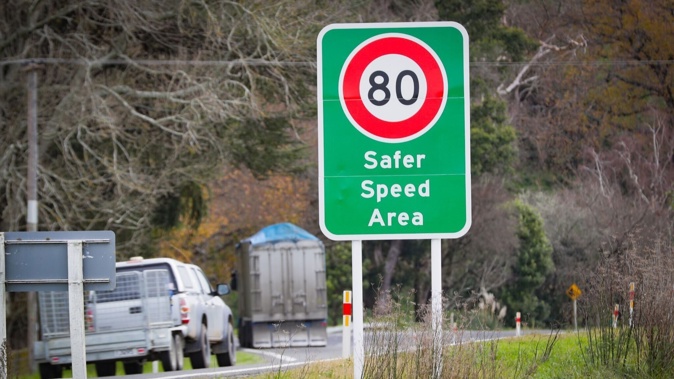
The Green Party says the Government’s move to get rid of “blanket” speed limits disregards evidence about safety and will lead to serious injuries.
Transport Minister Simeon Brown today held a conference in Auckland to unveil new speed limit rules.
The policy removes “blanket” speed restrictions in a bid to get traffic and economic production moving more efficiently, Brown said.
It aims to get councils and road control agencies to bring in variable reduced speed limits around schools at pick-up and drop-off times and remove a network of 30km/h restrictions on suburban roads in favour of 50km/h limits.
He also raised the possibility of future 120km/h limits on major motorways.
But Julie Anne Genter, the Green Party’s transport spokesperson, said the science behind road safety is “overwhelming”.
“Safe speeds save lives,” she said.
”Our kids should be free to walk and cycle to school without worry. Our streets should enable everyone to access their communities safely and sustainably.”
It comes as Auckland Council in July voted 18-3 against the Government’s plans at the time to raise speed limits back to their levels at the start of 2020.
In a split vote, 12-11, the council additionally voted to oppose the Government’s plan to allow “variable” speed limits around schools.
A survey commissioned by NZ Transport Agency Waka Kotahi also found Kiwis support lower speed limits around schools and other high-risk areas in a January to March survey of 1665 people.
Greens spokeswoman Genter said the Government is trying to force councils and communities to adopt unsafe speeds on “dangerous rural roads, in areas with lots of pedestrians and around schools for most of the day”.
”Local councils, health professionals and road safety experts from here and around the world have spoken out opposing this senseless policy, outlining the serious harm it will cause,” she said.
She argued that in Auckland, safer speeds were shown to increase trip times by less than 20 seconds on the average 20-minute car journey yet “massively” reduced deaths and serious injuries.
“Is 20 seconds worth the risk of a loved one being lost?” she asked.
”The reality is that people won’t notice getting to their destination seconds earlier, but will notice a family member not making it home.”
 Transport Minister Simeon Brown and Takanini MP Rima Nakhle at today's press conference. Photo / Sylvie Whinray
Transport Minister Simeon Brown and Takanini MP Rima Nakhle at today's press conference. Photo / Sylvie Whinray
She accused Brown of being “dangerously uninformed” and not following a National election policy of promising it would not return higher speeds where it would be unsafe to do so.
However, Brown said in Auckland today it was drunk driving and driving under the influence that were most responsible for the road death toll in the country.
“Alcohol and drugs are the highest contributing factor to fatal crashes on our roads, and that’s why we have increased alcohol breath testing targets and introduced legislation to roll out roadside drug testing to crack down on this reckless behaviour,” he said.
“Over 850,000 more alcohol breath tests were undertaken on our roads in 2023/24 compared to the previous year, saving 37 lives across the country.”
He said councils and road control authorities are still responsible for speed limits but the new policy gives them guidance on how to set speed limits.
They can set targeted lower speed limits based on evidence but cannot set blanket lower speed limits, Brown said.
Julie Anne Genter says the evidence is overwhelming that safe speeds save lives.
“The Ministry of Transport has advised me the risk to children is much greater at school pick-up times, and that is why blanket speed limits won’t be enforced outside of those times”, Brown said.
“We’re not going to make the tradie going to work at 4 or 5 in the morning crawl around our suburbs. That makes no sense.”
He said many Kiwis had been concerned that blanket lower speed limits had been introduced in the past without adequate consultation.
A key behind the new policy was also to enable the efficient movement of traffic, Brown said.
“When you reduce speed limits that increases the travel time,” he said.
“We want to create efficient networks.”
The key changes announced were:
- Reverse Labour’s blanket speed limit reductions on local streets, arterial roads, and state highways by July 1, 2025.
- Require reduced variable speed limits outside schools during pick-up and drop-off times by July 1, 2026.
- Enable speed limits up to 120km/h on Roads of National Significance where it is safe.
It comes after the Government earlier this month unveiled its $32.9 billion National Land Transport Plan for 2024-2027.
Spending will be focused on road maintenance, new road construction and public transport infrastructure, Brown said at the time.
That included a $5.5b swathe being dedicated to fixing potholes, while another $4.6b was earmarked for the maintenance and operations of state highways and local roads (which are jointly funded by councils).
The NZ Transport Agency Waka Kotahi will spend $7b on state highway improvements – that means building new roads for the state highway network and $6.4b on building new public transport infrastructure and paying subsidies to local councils to operate the network.
As part of that announcement Brown said less money needed to be spent on cycleways and speed bumps.
Rail was another area that faced funding cuts, going from $1.3b in the last plan to $1b in this one.
Auckland was held up as a big winner by the Government though, with about a quarter of the funding at $8.4b, and more than half the public transport spend at $3.7b, being set aside for the super city.
 The Government in August also unveiled a proposal to allow motorists to drive up to 110km/h north of Auckland.
The Government in August also unveiled a proposal to allow motorists to drive up to 110km/h north of Auckland.
In late August, Brown also travelled north of Auckland to announce motorists could soon be driving at speeds up to 110km/h between Ōrewa and Warkworth.
The Government proposed raising speed limits along the 25km stretch of modern motorway, up from 100km/h.
Take your Radio, Podcasts and Music with you









